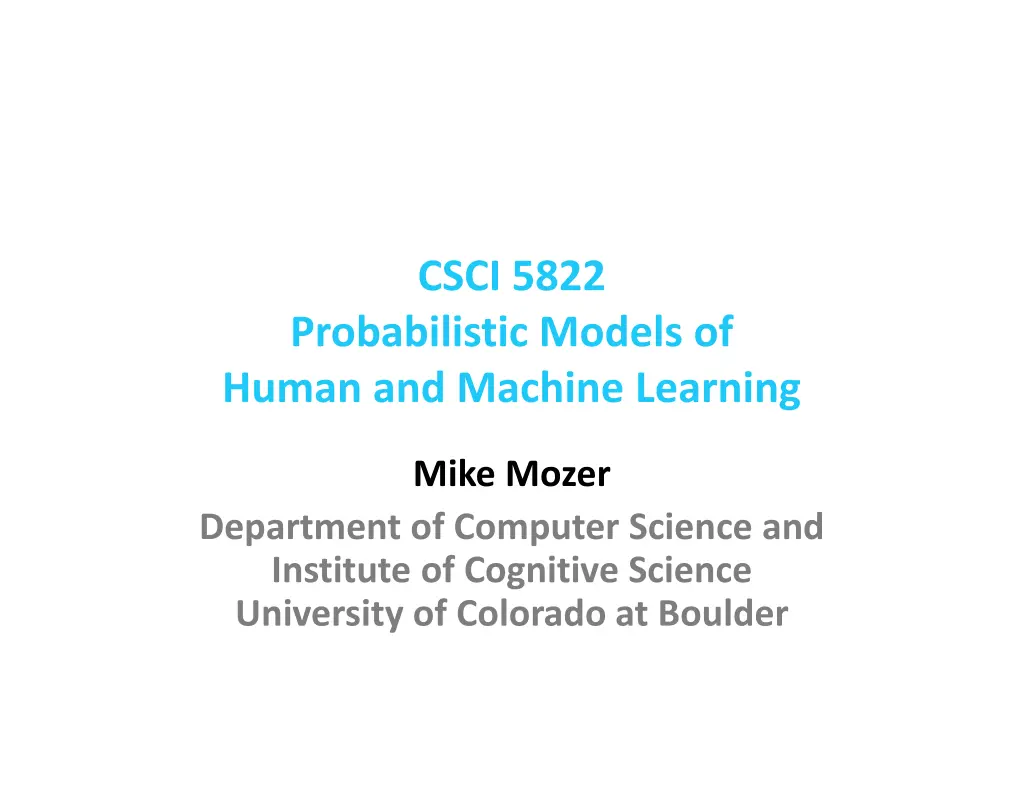
Probabilistic Models of Human and Machine Learning
Discover Gaussian Processes and how they tackle overfitting issues in limited data scenarios. Explore regularization methods, Bayesian approaches, and the intuition behind Gaussian processes in this insightful content from Mike Mozer at the University of Colorado Boulder.
Download Presentation

Please find below an Image/Link to download the presentation.
The content on the website is provided AS IS for your information and personal use only. It may not be sold, licensed, or shared on other websites without obtaining consent from the author. If you encounter any issues during the download, it is possible that the publisher has removed the file from their server.
You are allowed to download the files provided on this website for personal or commercial use, subject to the condition that they are used lawfully. All files are the property of their respective owners.
The content on the website is provided AS IS for your information and personal use only. It may not be sold, licensed, or shared on other websites without obtaining consent from the author.
E N D
Presentation Transcript
CSCI 5822 Probabilistic Models of Human and Machine Learning Mike Mozer Department of Computer Science and Institute of Cognitive Science University of Colorado at Boulder
Gaussian Processes For Regression, Classification, and Prediction
How Do We Deal With Many Parameters, Little Data? 1. Regularization e.g., smoothing, L1 penalty, drop out in neural nets, large K for K-nearest neighbor 2. Standard Bayesian approach specify probability of data given weights, P(D|W) specify weight priors given hyperparameter , P(W| ) find posterior over weights given data, P(W|D, ) With little data, strong weight prior constrains inference 3. Gaussian processes place a prior over functions directly rather than over model parameters, W
Problems That GPs Solve Overfitting In problems with limited data, the data themselves aren t sufficient to constrain the model predictions Uncertainty in prediction Want to not only predict test values, but also estimate uncertainty in the predictions Provide a convenient language for expressing domain knowledge Prior is specified over function space Intuitions are likely to be stronger in function space than parameter space E.g., smoothness constraints on function, trends over time, etc.
Intuition Figures from Rasmussen & Williams (2006) Gaussian Processes for Machine Learning
Demo http://chifeng.scripts.mit.edu/stuff/gp-demo/
Important Ideas Nonparametric model complexity of model posterior can grow as more data are added compare to polynomial regression Prior determined by one or more smoothness parameters We will learn these parameters from the data
Gaussian Distributions: A Reminder Figures stolen from Rasmussen NIPS 2006 tutorial
Gaussian Distributions: A Reminder Marginals of multivariate Gaussians are Gaussian Figure stolen from Rasmussen NIPS 2006 tutorial
Gaussian Distributions: A Reminder Conditionals of multivariate Gaussians are Gaussian
Stochastic Process Generalization of a multivariate distribution to countably infinite number of dimensions Collection of random variables G(x) indexed by x E.g., Dirichlet process x: parameters of mixture component x: possible word or topic in topic models Joint probability over any subset of values of x is Dirichlet P(G(x1), G(x2), , G(xk)) ~ Dirichlet(.)
Gaussian Process notation Switch Infinite dimensional Gaussian distribution, F(x) Draws from Gaussian Process are functions G0 -> F G -> f G(x) -> f(x) f ~ GP(.) f x
Gaussian Process Joint probability over any subset of x is Gaussian P(f(x1), f(x2), , f(xk)) ~ Gaussian(.) Consider relation between 2 points, x1and x2 f(x1) constrains the value of f(x2) f x x1x2
Gaussian Process How do points covary as a function of their distance? f f x x x1x2 x2 x1
From Gaussian Distribution To Gaussian Process A multivariate Gaussian distribution is defined by a mean vector and a covariance matrix. A Gaussian process is fully defined by a mean function and a covariance function f(x)~ GP(m(x),k(xi,xj)) m(x)= E[ f(x)] k(xi,xj)= E[(f(xi)- m(xi))(f(xj)- m(xj))] Example m(x)= 0 squared exponential covariance 2/2l2) k(xi,xj)= exp(- xi- xj l: length scale
Inference GP specifies a prior over functions, F(x) Suppose we have a set of observations: D = {(x1,y1), (x2, y2), (x3, y3), , (xn, yn)} Bayesian approach p(F|D) ~ p(D|F) p(F) If data are noise free yi f(xi) P(D|F) = 0 if any P(D|F) = 1 otherwise
Graphical Model Depiction of Gaussian Process Inference train test observed unobserved
GP Prior where X =[x1x2x3... xn] X*=[x1 *x2 *x3 *... xm *] *,x1) . . *,x1) *,xn) . . *,xn) k(x1 . . k(x1 K(X*,X)= k(xm . . k(xm GP Posterior Predictive Distribution Y, Y
Observation Noise 2) y= f(x)+e, with e ~ (0,sn What if Covariance function becomes 2/2l2)+sn 2dij k(xi,xj)= exp(- xi- xj Posterior predictive distribution becomes
What About The Length Scale? 2/2l2)+sn 2dij k(xi,xj)= exp(- xi- xj
Full-Blown Squared-Exponential Covariance Function Has Three Parameters 2/2l2)+sn 2exp(- xi- xj 2dij k(xi,xj)=sf How do we determine parameters? Prior knowledge Maximum likelihood Bayesian inference Potentially many other free parameters e.g., mean function m(x)=a0+a1x
Many Forms For Covariance Function From GPML toolbox
Many Forms For Likelihood Function What is likelihood function? noise free case we discussed 1 0 if y = f(x) otherwise p(y f(x))= noisy observation case we discussed 2) p(y f(x))= (f(x),sn With these likelihoods, inference is exact Gaussian process is conjugate prior of Gaussian likelihood (Works for noisy observations because noise is incorporated into covariance function.)
Customizing Likelihood Function To Problem Suppose that instead of real valued observations y, observations are binary {0, 1}, e.g., class labels f(x) 1 p(y f(x))= 1+exp(- f(x)) y
Many Approximate Inference Techniques For GPs Choice depends on likelihood function From GPML toolbox
What Do GPs Buy Us? Choice of covariance and mean functions seem a good way to incorporate prior knowledge e.g., periodic covariance function As with all Bayesian methods, greatest benefit is when problem is data limited Predictions with error bars An elegant way of doing global optimization
